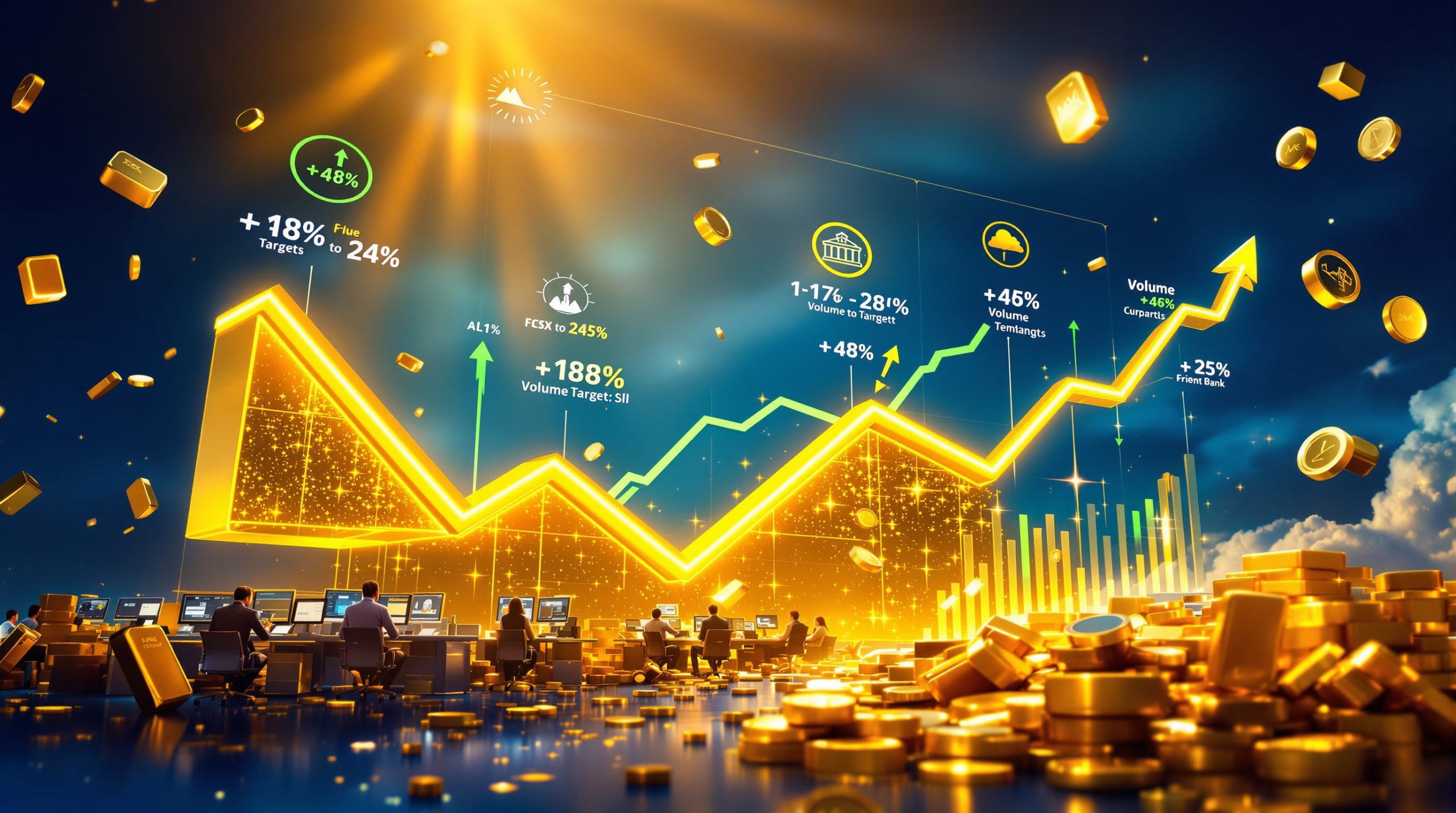Understanding the Current Gold and Silver Surge Playbook
The precious metals market has entered an unprecedented phase of momentum, creating opportunities that demand strategic positioning from Australian investors. Current market conditions represent a convergence of monetary policy shifts, industrial demand acceleration, and geopolitical uncertainty that could sustain elevated prices through 2026.
This surge extends beyond typical commodity cycles. The gold and silver surge playbook encompasses fundamental changes in global monetary systems, with central banks accumulating record quantities of gold while industrial sectors consume silver at rates that stress traditional supply chains.
Defining Today's Precious Metals Environment
Market dynamics in late 2025 reflect three critical forces reshaping investor behaviour worldwide. Furthermore, declining real interest rates across major economies have eliminated the opportunity cost of holding non-yielding assets like gold and silver. When government bonds provide negative real returns after accounting for inflation, precious metals become compelling alternatives for wealth preservation.
Geopolitical tensions have intensified safe-haven demand beyond historical norms. Trade disputes, currency debasement concerns, and regional conflicts drive institutional investors toward defensive allocations in physical assets. This shift represents a structural change rather than temporary positioning.
Supply constraints create the third pillar supporting higher prices. Both gold and silver face production limitations that cannot respond quickly to price signals, particularly silver where byproduct mining dominates total supply.
Macroeconomic Forces Behind the Precious Metals Rally
The Real Yield Revolution
Central bank policies across developed economies have fundamentally altered the investment landscape. According to sharecare's latest analysis, real yields on 10-year Treasury Inflation-Protected Securities have compressed from their 2023 peaks, creating negative real returns when adjusted for current inflation expectations.
This environment makes precious metals particularly attractive. Historical research demonstrates that gold prices exhibit strong negative correlation with real interest rates, typically ranging from -0.5 to -0.8 over extended periods. However, when real yields decline, the opportunity cost of holding gold diminishes significantly.
Key Real Yield Indicators:
- US 10-year TIPS yields: Currently negative after inflation adjustment
- Australian government bond real returns: Below zero across most maturities
- European sovereign debt: Negative real yields persist across major economies
- Central bank policy rates: Remain below neutral rates in most jurisdictions
The World Gold Council reports that central banks purchased 694 tonnes of gold in the first three quarters of 2024, following record acquisitions of 1,082 tonnes in 2023. This institutional demand reflects growing concerns about currency stability and desire for portfolio diversification away from traditional reserve assets.
Monetary Policy Uncertainty and Currency Debasement
Global monetary authorities face unprecedented challenges balancing inflation control with economic growth. This policy uncertainty drives demand for assets that maintain purchasing power over extended periods. In addition, the gold all-time highs demonstrate gold's effectiveness during periods of currency instability.
The dollar's role as the global reserve currency faces scrutiny as alternative payment systems develop and central banks diversify their holdings. While the dollar remains dominant, increasing bilateral trade agreements using alternative currencies suggest structural changes in the international monetary system.
Silver's Unique Industrial Demand Profile
Green Technology Consumption Explosion
Silver's industrial applications distinguish it fundamentally from gold's primarily monetary role. The Silver Institute's World Silver Survey 2024 reveals that industrial demand reached approximately 539 million ounces in 2023, with photovoltaic applications consuming 161 million ounces, representing 21% year-over-year growth.
Verified Silver Industrial Demand (2023):
| Sector | Consumption (Million oz) | Growth Rate |
|---|---|---|
| Solar Panels | 161 | +21% |
| Electronics | 234 | +8% |
| Automotive | 61 | +15% |
| Medical Devices | 55 | +12% |
The International Energy Agency projects substantial growth in solar photovoltaic installations through 2030 as part of global decarbonisation efforts. Each gigawatt of traditional solar panel manufacturing capacity requires approximately 10-14 tonnes of silver, creating structural demand growth linked directly to renewable energy deployment.
Critical Supply Structure Constraints
Silver's supply structure creates inherent inelasticity that amplifies price movements. Furthermore, the silver market squeeze reveals that primary silver mine production represents only 28% of total mine supply in 2023, with byproduct and co-product silver from base metal mining accounting for 72% of supply.
This structural characteristic means silver production from base metal mines responds to copper, lead, and zinc prices rather than silver prices. When silver demand surges, supply cannot adjust quickly because most production decisions depend on the economics of primary base metals.
Technical Silver Applications:
Silver's use in solar panels stems from its superior electrical conductivity and corrosion resistance. It forms the conductive grid on silicon photovoltaic cells through metallisation paste applications. While manufacturers continuously work to reduce silver content per cell through thrifting techniques, absolute consumption continues rising due to overall installation growth.
Electronic applications leverage silver's exceptional thermal and electrical conductivity properties. From smartphones to automotive electronics, silver paste and wire bonding remain essential for high-performance applications where substitution compromises functionality.
Investment Vehicle Analysis for Precious Metals Exposure
Physical Precious Metals Strategies
Direct ownership through allocated storage provides the purest exposure to precious metals price movements but requires careful consideration of storage costs, insurance, and liquidity factors. Australian investors can access physical metals through several established channels.
The Perth Mint, a statutory authority of the Western Australian government, offers depository certificates backed by the state government guarantee. These certificates provide ownership of allocated metal stored in Perth Mint facilities, combining physical exposure with institutional-grade security.
Physical Investment Considerations:
- Allocated vs. unallocated storage options
- Insurance coverage and counterparty risk
- Liquidity and transaction costs
- Tax implications for physical holdings
- Storage security and accessibility
Exchange-Traded Fund Options
Precious metals ETFs offer liquid exposure without physical storage complications, making them suitable for portfolio integration and tactical allocation adjustments. Consequently, these products represent the most accessible way for retail investors to gain precious metals exposure.
ASX-Listed Gold ETFs:
| Fund | Expense Ratio | Backing Method | Key Features |
|---|---|---|---|
| GOLD (Perth Mint) | 0.59% | Physical gold | Government guarantee |
| QAU (BetaShares) | 0.59% | Physical gold | LBMA approved bars |
Physically-backed ETFs hold actual metal in allocated vaults with investors maintaining claims on specific bars. This structure provides direct precious metals exposure while maintaining daily liquidity through exchange trading.
Futures-based ETFs gain exposure through commodity futures contracts, which can result in tracking differences due to roll costs and contango or backwardation in futures markets. These structural differences matter for long-term holdings but may be less relevant for shorter-term tactical positions.
Precious Metals Mining Equities
Mining companies provide leveraged exposure to precious metals prices through operational leverage. Because substantial portions of operating costs remain fixed, increases in commodity prices flow disproportionately to margins and earnings.
Academic research documents that gold mining equities typically demonstrate beta of 1.5-2.5x relative to gold prices over extended periods. This amplification works in both directions, creating higher volatility than direct metal ownership.
ASX-Listed Companies Positioned for the Precious Metals Surge
Major Gold Producers
Newmont Corporation (NEM on ASX):
Newmont stands as the world's largest gold mining company, reporting attributable gold production of approximately 5.8 million ounces for FY2024. All-In Sustaining Costs reached approximately $1,360 per ounce, positioning the company well for continued profitability at current gold price levels.
The company operates diversified assets across multiple jurisdictions, reducing single-mine risk while providing exposure to different geological and regulatory environments. This diversification strategy helps mitigate operational risks inherent in mining operations.
Australian-Focused Gold Producers:
Northern Star Resources (NST) represents a major ASX-listed gold producer operating the Kalgoorlie Consolidated Gold Mines with 50% ownership alongside the Pogo mine in Alaska. FY2024 production reached approximately 1.5 million ounces with AISC of approximately A$1,700-1,800 per ounce.
Evolution Mining (EVN) operates mines across Australia and Canada, producing approximately 700,000-750,000 ounces in FY2024. The company's focus on Tier-1 jurisdictions reduces regulatory risk while maintaining exposure to favourable mining environments.
Understanding All-In Sustaining Costs (AISC)
AISC represents an industry-standard metric developed by the World Gold Council that provides comprehensive cost analysis including:
- Direct mining costs (mining, processing, site administration)
- Sustaining capital expenditures
- Corporate general and administrative costs
- Reclamation and remediation costs
This metric provides more accurate assessment of true gold production costs compared to cash costs alone, helping investors evaluate mining company margins at different gold price levels.
Silver-Focused Investment Options
Pure-play silver miners remain limited on the ASX, creating concentration risk for investors seeking direct silver mining exposure. Most Australian-listed companies with silver exposure produce it as a byproduct of base metal or gold mining operations.
International silver ETFs provide broader sector access through diversified holdings of global silver mining companies. For instance, these funds offer exposure to silver price movements while spreading operational risks across multiple companies and jurisdictions.
Risk Management for Precious Metals Investments
Market Correction Scenarios
Precious metals remain cyclical assets subject to significant corrections during bull market phases. World Gold Council historical data shows gold has experienced multiple corrections of 15-30% during secular bull markets, with the 2011-2015 bear market demonstrating a 45% decline from peak to trough.
Primary Risk Factors:
- Real yield reversals if central banks tighten monetary policy aggressively
- Dollar strength reducing international precious metals demand
- Economic recession causing liquidity-driven asset selling
- Speculative excess leading to bubble-like price conditions
The Federal Reserve's monetary policy stance remains critical for precious metals performance. If inflation moderates more quickly than expected while the Fed maintains or raises real interest rates, the opportunity cost of holding gold increases substantially. This scenario triggered sharp corrections during the 2013 taper tantrum when Fed asset purchase reduction signals caused gold prices to decline rapidly.
Mining-Specific Operational Risks
Gold and silver mining operations face several company-specific risks that can materially impact investment returns:
Geopolitical and Regulatory Risk: Mining operations in certain jurisdictions face nationalisation threats, changing tax regimes, and evolving environmental regulations that can destroy project economics overnight.
Reserve Replacement Challenge: Mining represents a depleting business model. Companies must continually discover and develop new reserves to maintain production levels, requiring substantial capital investment with uncertain returns.
Operational Execution Risk: Mining projects frequently experience cost overruns, construction delays, and technical challenges that can eliminate expected returns. Ernst & Young's annual mining risk survey consistently identifies operational execution as a primary value destruction factor.
Hedging Policy Risk: Some mining companies use derivatives to hedge future production, which can limit upside participation when precious metals prices rise significantly. Understanding each company's hedging policy becomes crucial during bull market phases.
Portfolio Integration and Position Sizing
Research published in the Journal of Portfolio Management found that gold allocations of 5-10% in diversified portfolios improved risk-adjusted returns over 30-year periods. However, optimal allocation varies significantly based on individual circumstances and market conditions.
Risk Management Framework:
- Maximum combined precious metals allocation: 15% of total portfolio
- Stop-loss considerations: 15-20% below entry points for trading positions
- Dollar-cost averaging: Regular purchases during accumulation phases
- Rebalancing discipline: Return to target weights when allocations deviate significantly
Building a Strategic Precious Metals Portfolio
Core-Satellite Allocation Framework
Effective precious metals investing requires systematic approach combining long-term strategic positions with tactical opportunities:
Strategic Core Holdings (8-12% of total portfolio):
- Physical metals or physically-backed ETFs for wealth preservation
- Focus on liquidity and low tracking error
- Hold through market cycles without trading
Satellite Positions (3-5% of total portfolio):
- Quality mining companies for leveraged exposure
- Select during periods of relative weakness
- Focus on companies with strong balance sheets and low-cost operations
Tactical Trading Allocation (1-2% of total portfolio):
- Momentum-based opportunities during strong price moves
- Short-term positions based on technical analysis
- Higher risk tolerance for potential amplified returns
Implementation Timeline and Strategy
Phase 1 (Immediate): Establish Foundation
Build core precious metals positions through established ETFs or physical metal purchases. Focus on quality over quantity, emphasising liquid instruments that provide direct price exposure.
Phase 2 (3-6 months): Add Mining Equity Exposure
Introduce mining company positions during periods of relative weakness compared to underlying metals. Target companies with strong operational metrics and diversified asset bases.
Phase 3 (6-12 months): Implement Dynamic Management
Develop systematic rebalancing processes based on price action and relative performance. Maintain disciplined approach to position sizing regardless of price momentum.
Dollar-Cost Averaging Considerations
Dollar-cost averaging involves regular periodic investments of fixed amounts regardless of price levels. This approach can reduce timing risk and average out purchase prices over market cycles, particularly valuable for volatile assets like precious metals.
Academic research shows that lump-sum investing typically outperforms dollar-cost averaging in rising markets due to immediate full exposure. However, for precious metals during bull market phases, dollar-cost averaging may provide psychological benefits by reducing regret risk and allowing gradual position building.
Tax Considerations for Australian Precious Metals Investors
Australian investors must understand the tax implications of different precious metals investment structures:
Physical Precious Metals: Subject to capital gains tax (CGT) when sold, with potential access to CGT discount for assets held longer than 12 months.
Precious Metals ETFs: Generally treated as shares for tax purposes, subject to CGT on disposal and potentially eligible for franking credits depending on fund structure.
Mining Company Shares: Standard share taxation rules apply, including CGT on disposal and dividend income taxation at marginal rates.
Monitoring Market Signals and Exit Strategies
What Are the Key Technical Price Levels?
Successful precious metals investing requires attention to key technical and fundamental indicators:
Gold Price Levels to Watch:
- Current support: $2,650-2,700/oz
- Resistance levels: $2,800/oz and $3,000/oz
- Long-term targets depend on sustained monetary conditions
Silver Price Technical Analysis:
- Immediate resistance: $35/oz
- Breakout confirmation: Sustained moves above $38/oz
- Historical volatility suggests 2:1 silver-to-gold performance ratios during bull phases
Fundamental Indicator Monitoring
Track key fundamental drivers that could signal trend changes:
- Real yield movements across major economies
- Central bank gold purchase patterns and policy statements
- Industrial demand trends, particularly in solar and electronics sectors
- Currency stability measures and reserve diversification trends
- Inflation expectations and monetary policy pivot points
The gold inflation hedge characteristics become particularly relevant when monitoring these fundamental indicators. Moreover, expert analysis on gold market performance suggests sustained momentum depends on continued monetary accommodation.
Conclusion: Executing the Gold and Silver Surge Playbook
The current precious metals surge represents a multi-year opportunity driven by structural shifts in monetary policy, accelerating industrial demand, and persistent geopolitical uncertainty. Success requires combining strategic long-term positioning with tactical flexibility to navigate inevitable volatility periods.
Australian investors should prioritise quality exposure through established ETFs and financially strong mining companies while maintaining appropriate risk management disciplines. Furthermore, the gold market surge effectiveness depends more on disciplined execution and position sizing than perfect market timing.
Current market conditions favour precious metals allocation as part of a diversified portfolio strategy. However, investors must remain prepared for significant price swings and maintain realistic expectations about returns and volatility. The gold price forecast indicates continued upward momentum through 2025, supported by fundamental drivers.
Investment Disclaimer: This analysis represents general market commentary and should not be considered personalised investment advice. Precious metals investments carry significant risks including price volatility, operational risks for mining companies, and potential total loss of investment. Consult qualified financial advisors and review relevant Product Disclosure Statements before making investment decisions.
The precious metals market will continue evolving as monetary conditions and industrial applications develop. Successful investors will adapt their strategies while maintaining core exposure to these fundamental stores of value during uncertain economic times.
Ready to Capitalise on the Next Significant Mineral Discovery?
Discovery Alert instantly alerts investors to significant ASX mineral discoveries using its proprietary Discovery IQ model, turning complex mineral data into actionable insights. Begin your 30-day free trial today and discover why historic discoveries generate substantial returns by exploring Discovery Alert's dedicated discoveries page.




